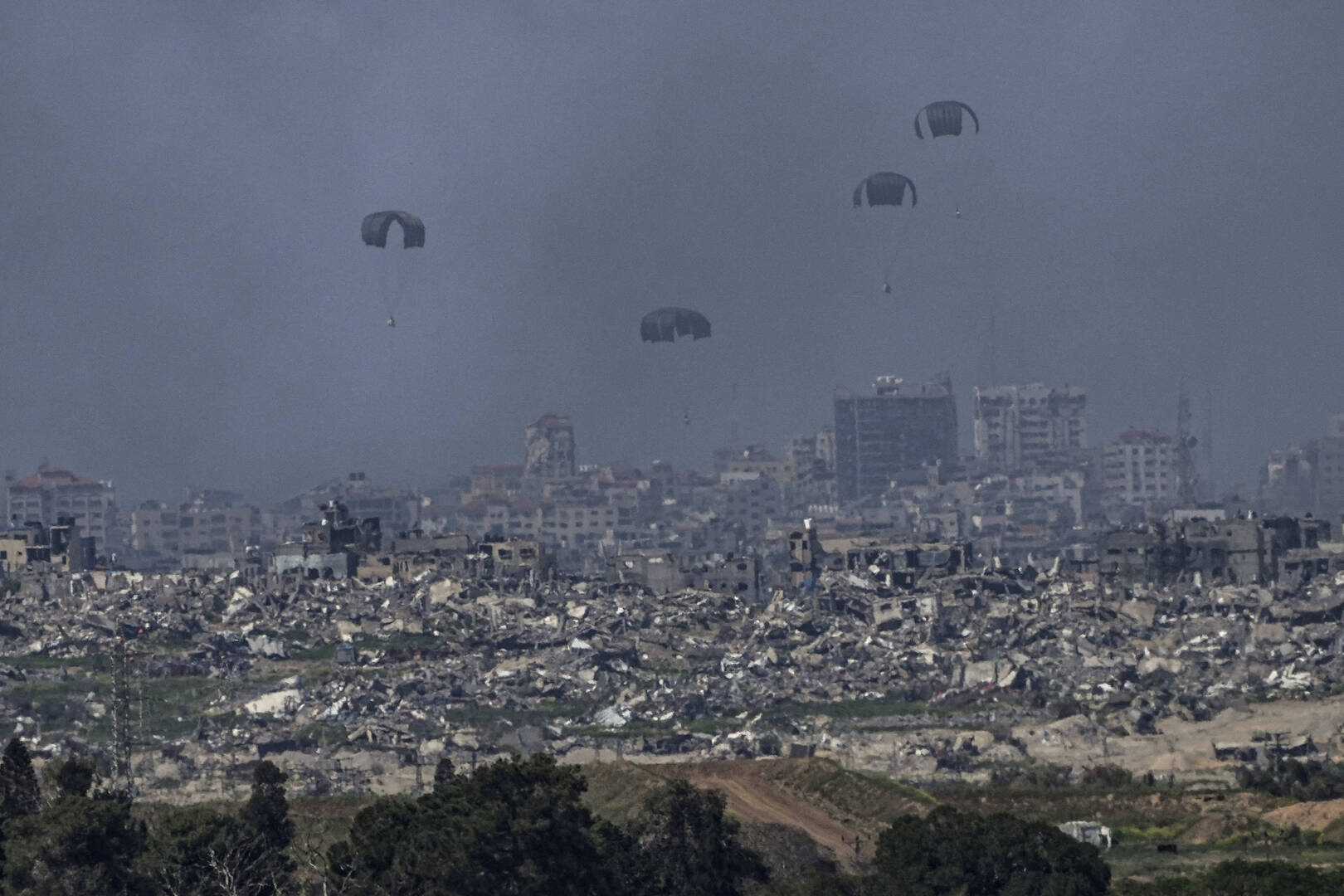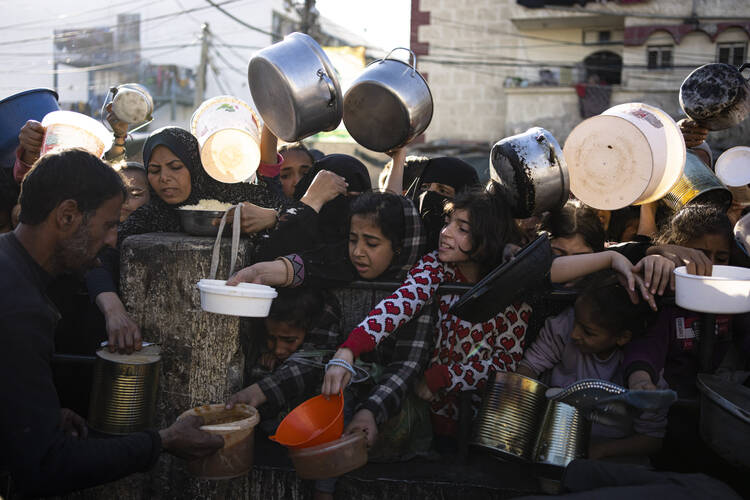The Weekly Dispatch takes a deep dive into breaking events and issues of significance around our world and our nation today, providing the background readers need to make better sense of the headlines speeding past us each week. For more news and analysis from around the world, visit Dispatches.
How bad is the humanitarian crisis in Gaza as the conflict between Hamas and Israel enters its sixth month?
Cornelia Sage is Catholic Relief Services’ head of programs for its Jerusalem/West Bank/Gaza office. On March 11, she returned from a harrowing visit to Gaza where “nowhere is safe” and “hunger is everywhere.”
Gazans have little to no access to clean water. Fuel to run well-water pumps is scarce and what little is available can only be purchased at hyperinflated prices. Those who can reach it are bathing in the surf of the Mediterranean Sea, she said.
Meanwhile, people weakened by hunger and dehydration cannot find medical help. Most of Gaza’s health services have been damaged or obliterated. The United Nations reports that just 12 out of 36 hospitals across Gaza remain even partially functioning, and only two provide maternity services—even as 180 women in Gaza are giving birth each day.
According to the United Nations, 90 percent of the Gaza community currently faces acute food insecurity and 25 percent outright starvation. Humanitarian relief agencies expect that a famine in Gaza will officially be declared in the next update of the Integrated Food Security Phase Classification system.
That war-caused famine appears to be in full effect this week, as reports surfaced of deaths because of starvation and deprivation. On March 12, the Ministry of Health in Gaza reported that 27 people, including 23 children, have died of malnutrition and dehydration at hospitals in northern Gaza.
While conditions are poor near the border with Egypt, where hundreds of thousands of Palestinians have taken refuge from air strikes and ground combat, the overcrowded camps in the southern city of Rafah are at least in proximity to aid delivery platforms. But thousands of Palestinians who remain in northern Gaza have been for the most part cut off completely from humanitarian aid. Some have been reduced to eating animal feed mixed with flour. An attempt to deliver aid in the north on Feb. 29 ended in chaos and bloodshed, as Israeli Defense Forces troops opened fire on hundreds of people swarming trucks attempting to deliver food supplies.
In normal times, 500 trucks a day come into Gaza to support the Palestinian community confined to the strip. Now, sometimes only 100 trucks or less are allowed through the Rafah crossing. “There is a tremendous amount of aid that is lined up that isn’t able to get through,” Ms. Sage said, reporting that thousands of trucks are backed up for miles from the border with Egypt, awaiting security clearance.
C.R.S. has managed to keep operations running in Rafah in the south and Deir al-Balah in the middle of Gaza. According to Ms. Sage, C.R.S. is working to expand those efforts and has provided assistance to more than 80,000 households since October.
“They’re both urban centers that haven’t been impacted by the ongoing ground operations,” she said. But in Al-Mawasi, a town on the southern coast of the strip, “thousands and thousands and thousands of people have set up makeshift shelters…but there’s nothing there,” she said.
“At least in the urban centers you might have access to markets and the little bit of food that is being sold. In this area, there’s nothing: no access to water, no access to food—obviously no access to education or health services anywhere [in Gaza]. But this place is particularly desolate, with a lack of basic services.”
One C.R.S. team member is caring for her children in a tent in Al-Mawasi. She has had to direct her children to find cover in the sand during Israeli incursions. Eight months pregnant, she is desperate to avoid delivering an infant into such difficult and dangerous circumstances.
“How am I supposed to bring a newborn baby back to a tent?” the woman asked Ms. Sage.
“I have another staff member who has family, parents in the north. She said she felt guilty every time she ate because she knew her parents didn’t have any food.”
Ms. Sage reports that C.R.S. team members in Gaza are among the only people still able to work and earn a salary in the strip. That means some C.R.S. staff are supporting scores of extended family members. “We have staff members who have 50 to 60 people living in one apartment,” she said. Her team members are exhausted. People are losing hope, she said.
Cardinal Pierbattista Pizzaballa, the Latin Patriarch of Jerusalem, issued an appeal for a cease-fire on March 5, describing himself as full of dismay because of the chaos and hunger that has engulfed Gaza. The patriarch said supplies of food and drinking water were dangerously low in north Gaza.
“The situation is increasingly fragile,” he said. “Medicines are also lacking; practically everything is missing. I think everyone realizes that we cannot go on like this. I have seen that they have started to drop parachutes with food parcels, but other, more coordinated, systematic solutions need to be found because, if we continue like this, it will simply be chaos upon chaos.”

The cardinal’s logistical concerns have been echoed by humanitarian organizations. A shipment by sea of 200 tons of food is on its way to Gaza from Cyprus and expected to land on March 14. The shipment is a test for the opening of a sea corridor to supply aid to the territory.
The Jordanian and U.S. militaries began air-dropping pallets of food and other humanitarian supplies over northern Gaza beaches in March. Unfortunately, some casualties have been reported on the ground after parachutes malfunctioned on several pallets. During his State of the Union address on March 7, U.S. President Joe Biden said the U.S. military was planning the construction of a temporary pier in north Gaza to facilitate aid delivery.
“This temporary pier would enable a massive increase in the amount of humanitarian assistance getting into Gaza every day,” Mr. Biden said in his address. “But Israel must also do its part. Israel must allow more aid into Gaza and ensure that humanitarian workers aren’t caught in the crossfire.”
U.N. officials agree the most effective humanitarian response could be secured by aid delivery overland, calling for greater cooperation with Israeli screeners at Rafah and an immediate cease-fire that would allow aid trucks through.
Some aid did reach north Gaza this week along what could potentially become a new humanitarian corridor. The Israeli military announced on March 13 that a World Food Program convoy had for the first time entered the Gaza Strip through a crossing in the northern half of the territory. An I.D.F. spokesperson described the delivery as a test run and said the Israeli government would review the results. The convoy represents the first aid to reach northern Gaza since Feb. 20.
Josep Borrell, the European Union’s foreign policy chief, charged that Israel is using starvation as a weapon of war and accused it of blocking overland routes.
“This is a man-made crisis,” Mr. Borrell told the U.N. Security Council on March 12. “And when we look for alternative ways of providing support by sea or by air, we have to remind [the international community] that we have to do it because the natural way of providing support to roads is being closed—artificially closed—and starvation is being used as a war arm and when we condemned this happening in Ukraine, we have to use the same words for what is happening in Gaza.”
George Akroush, director of the Project Development Office for the Latin Patriarchate of Jerusalem, told Aid to the Church in Need that about 560 people remained at the Holy Family church compound near Gaza City. More than 700 Gazan Christians first assembled there as the fighting began in October. According to Mr. Akroush, some Christians with dual citizenship have been able to leave and 30 Christian Palestinians died during fighting in and around the church compound.
Among those who perished were 17 people killed in an attack on the Greek Orthodox parish compound in October, as well as two women killed by sniper fire at Holy Family. Another 11 people died because of chronic illness that went untreated. Mr. Akroush told A.C.N. that another 10 chronically ill people at Holy Family are at risk of dying.
More than 60 percent of the housing stock in Gaza has been destroyed, and U.N. and aid agencies estimate that reconstruction could take years. “What future is there for Christians in this country?” Mr. Akroush asked. “What is going to happen? Nobody knows. Please pray for us, and do not forget the suffering of Christians in this part of the world.”
The Gaza Ministry of Health reported on March 14 that 69 people had died in Gaza over the last 24 hours. According to the ministry, 31,341 Palestinians have been killed and more than 73,000 wounded since the fighting began in October. The ministry does not differentiate between civilians and combatants in its count of the dead and wounded, but reports that women and children make up two-thirds of the dead. Most of Gaza’s 2.3 million people have been forced from their homes.
Hamas launched a deadly raid into southern Israel on Oct. 7 with the operational code name “Al-Aqsa Storm,” beginning the current conflict in the apparent belief that the ensuing suffering would compel a regional response against Israel. Its attack indeed provoked a wider war in Gaza and has inspired attacks by Hezbollah in Lebanon, strikes against U.S. forces in Syria and Iraq, and rocket attacks on shipping in the Red Sea by Houthi militants in Yemen, but so far a broader conflict that might include Iran and Arab states has not materialized.
Analysts warn, however, that the potential for the conflict to spread to Jerusalem and other West Bank cities is high as the holy month of Ramadan begins and as the bloodshed and hunger in Gaza continue. Ceasefire negotiations are stalled, and Israeli forces are poised for a final assault on Hamas holdouts in Rafah. More violence, especially any disturbances related to the Al-Aqsa mosque in Jerusalem, could ratchet up regional tensions against Israel and the West, especially Israel’s primary military patron, the United States.
More from America
- The Editors: Gaza, Ukraine and what makes a 'just war'
- ‘We can live together’: A Palestinian doctor and political activist on Gaza, a ceasefire and the future of Israel-Palestine
- Wars end in defeat for everyone: A reflection on Gaza
- No end in sight to Palestinian suffering after collapse of latest ceasefire plan








